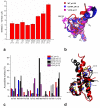Probing early misfolding events in prion protein mutants by NMR spectroscopy
- PMID: 23966072
- PMCID: PMC6270549
- DOI: 10.3390/molecules18089451
Probing early misfolding events in prion protein mutants by NMR spectroscopy
Abstract
The post-translational conversion of the ubiquitously expressed cellular form of the prion protein, PrPC, into its misfolded and pathogenic isoform, known as prion or PrPSc, plays a key role in prion diseases. These maladies are denoted transmissible spongiform encephalopathies (TSEs) and affect both humans and animals. A prerequisite for understanding TSEs is unraveling the molecular mechanism leading to the conversion process whereby most α-helical motifs are replaced by β-sheet secondary structures. Importantly, most point mutations linked to inherited prion diseases are clustered in the C-terminal domain region of PrPC and cause spontaneous conversion to PrPSc. Structural studies with PrP variants promise new clues regarding the proposed conversion mechanism and may help identify "hot spots" in PrPC involved in the pathogenic conversion. These investigations may also shed light on the early structural rearrangements occurring in some PrPC epitopes thought to be involved in modulating prion susceptibility. Here we present a detailed overview of our solution-state NMR studies on human prion protein carrying different pathological point mutations and the implications that such findings may have for the future of prion research.
Figures



Similar articles
-
Toward the molecular basis of inherited prion diseases: NMR structure of the human prion protein with V210I mutation.J Mol Biol. 2011 Sep 30;412(4):660-73. doi: 10.1016/j.jmb.2011.07.067. Epub 2011 Aug 4. J Mol Biol. 2011. PMID: 21839748
-
Observation of intermediate states of the human prion protein by high pressure NMR spectroscopy.BMC Struct Biol. 2006 Jul 17;6:16. doi: 10.1186/1472-6807-6-16. BMC Struct Biol. 2006. PMID: 16846506 Free PMC article.
-
NMR structural studies of human cellular prion proteins.Curr Top Med Chem. 2013;13(19):2407-18. doi: 10.2174/15680266113136660169. Curr Top Med Chem. 2013. PMID: 24059340 Review.
-
Molecular architecture of human prion protein amyloid: a parallel, in-register beta-structure.Proc Natl Acad Sci U S A. 2007 Nov 27;104(48):18946-51. doi: 10.1073/pnas.0706522104. Epub 2007 Nov 19. Proc Natl Acad Sci U S A. 2007. PMID: 18025469 Free PMC article.
-
Transmissible spongiform encephalopathies.Biochem Biophys Res Commun. 1998 Sep 18;250(2):187-93. doi: 10.1006/bbrc.1998.9169. Biochem Biophys Res Commun. 1998. PMID: 9753605 Review.
Cited by
-
Recognition Mechanisms between a Nanobody and Disordered Epitopes of the Human Prion Protein: An Integrative Molecular Dynamics Study.J Chem Inf Model. 2023 Jan 23;63(2):531-545. doi: 10.1021/acs.jcim.2c01062. Epub 2022 Dec 29. J Chem Inf Model. 2023. PMID: 36580661 Free PMC article.
-
Potential approaches for heterologous prion protein treatment of prion diseases.Prion. 2016;10(1):18-24. doi: 10.1080/19336896.2015.1123372. Prion. 2016. PMID: 26636482 Free PMC article.
-
Different misfolding mechanisms converge on common conformational changes: human prion protein pathogenic mutants Y218N and E196K.Prion. 2014 Jan-Feb;8(1):125-35. doi: 10.4161/pri.27807. Prion. 2014. PMID: 24509603 Free PMC article.
-
N-Glycosylation as a Modulator of Protein Conformation and Assembly in Disease.Biomolecules. 2024 Feb 27;14(3):282. doi: 10.3390/biom14030282. Biomolecules. 2024. PMID: 38540703 Free PMC article. Review.
-
The mechanisms of humic substances self-assembly with biological molecules: The case study of the prion protein.PLoS One. 2017 Nov 21;12(11):e0188308. doi: 10.1371/journal.pone.0188308. eCollection 2017. PLoS One. 2017. PMID: 29161325 Free PMC article.
References
-
- Prusiner S.B. Novel proteinaceous infectious particles cause scrapie. Science. 1982;216:136–144. - PubMed
-
- Ladogana A., Puopolo M., Croes E.A., Budka H., Jarius C., Collins S., Klug G.M., Sutcliffe T., Giulivi A., Alperovitch A., et al. Mortality from creutzfeldt-jakob disease and related disorders in europe, australia, and canada. Neurology. 2005;64:1586–1591. - PubMed
Publication types
MeSH terms
Substances
LinkOut - more resources
Full Text Sources
Other Literature Sources
Research Materials

